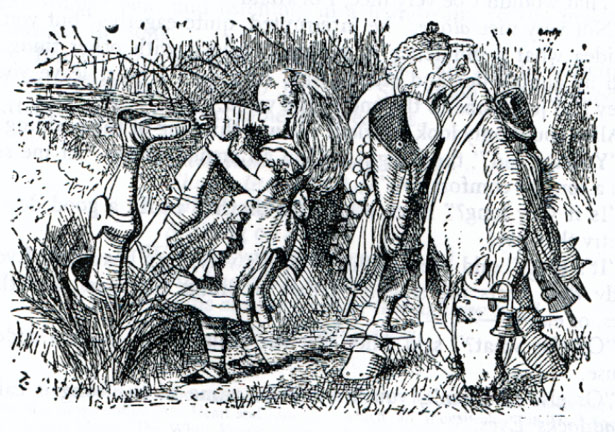
Alice helping the Knight out of a ditch — Illustration to the eighth chapter of Through the Looking Glass by John Tenniel. Wood-engraving by the Dalziels.
In 2000 student assistants from the University Scholars Program, National University of Singapore, scanned this image and added text under the supervision of George P. Landow. You may use this image without prior permission for any scholarly or educational purpose as long as you (1) credit the site and (2) link your document to this URL in a web document or cite the Victorian Web in a print one. [Click on this image and the one below to enlarge them, and, in the case of the image below, for more information.]
Commentary by Ray Dyer
The inevitable first impression here is of droll irony, as Tenniel faithfully portrays the ridiculous come-uppance of the heavily armoured White Knight, as he falls into the wayside ditch. This was not the artist's only foray into such amusing fantasy incidents, with their covert satire. Disguise was part of the professional armoury of both Tenniel and Lewis Carroll, and Tenniel would make use of a similar theme for his later portrayal in Punch of the pungent political issues surrounding London's River Thames: "Old Father Thames, and 'Who's to Blame?'" of 13 January 1877.

Tenniel's cartoon.
A secondary impression, of the artist's style here, may suggest a liking for his contemporaries, the Pre-Raphaelites, with their close observation of nature. Whilst limited to the use of white background and black pencil strokes for his botanical foray into reeds and wayside weeds, Tenniel nevertheless succeeds in making a radical break from the visual storytelling of such illustrious predecessors as George Cruikshank and John Leech. Both Tenniel and Carroll would have been familiar with the paintings of Holman Hunt, with his Hireling Shepherd of 1851, and its accurate rural landscape and hidden symbolic meanings; and John Millais, with his Ophelia of 1851, with its perfect harmony of detailed riverside vegetation and subtle Shakespearian hints. Such works, with their elevated moral themes, were popular throughout much the Victorian era. They may have given Carroll the cue for his humiliation of one of his own avatars in this kind of satire. As late as his final major fairytale book Carroll would continue in this vein, by "splitting" his pompous Professor avatar into two. Then, the Other Professor "lost for ever so long!", would be found hiding in a cupboard and "sitting in a chair, with a book on his knee" (Carroll, 1893, Ch. XX, "Gammon and Spinach"), before being further gently demeaned in later chapters.
The reader may also consider Alice's role in this episode. Could it be that only the sharp reversals of fact and fiction in Through The Looking-Glass allow us to accept the situation here — in which a child of some seven years of age is strong enough to drag a heavily laden mediaeval knight from a muddy ditch?
Bibliography
Carroll, Lewis. Sylvie and Bruno Concluded. London: Macmillan, 1893.
Last modified 6 September 2021